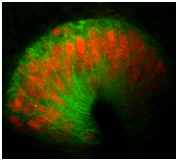Presentation
The origin of neurons and hair cells
One basic problem in development is to understand how specificcell types are generated from pluripotentprogenitors throughout embryonic life. We address this question by exploring the developmental origin of neurons and hair cells in ear. Both cell types derive from progenitors residing inthe neurosensory competent domain of the otic placode. Our research for the last years pursued the study of how this domain acquires this competence, and what are the molecular basis of cellular diversification.
Sox2 expression vestibular hair cells by Joana Neves
Specification of neuronal and hair cell fates depend on yet unknown interactions between proneural genes Neurog1 and Atoh1 and other upstream factors. We know that Sox2 and Notch play a crucial role in sensory development and that they interact during sensory specification. The central aim of our work has been to understand the regulation of Atoh1 in sensory precursors and the production of hair cells. We have dissected some crucial mechanisms that link Sox2, Notch and proneural genes Atoh1 and Neurog1 during otic neuronal and sensory development.
Hair cell regeneration: what can we do from embryonic development?
In the industrialized world hearing loss is a very common problem, affecting more than 250 million of people worldwide. Hearing loss is mostly caused by hair cell damage, which is due to genetic defects, aging, noise, traumatic lesions, infections or therapeutic substances. Hair cell replacement is an alternative strategy to treat hearing loss. The identification of key transcription factors controlling cell competence and differentiation is crucial for stem cell work and other regenerative strategies. Our research was also devoted to improve the knowledge of the molecular nature of sensory competence and the properties of NS progenitors, an essential background in pursue of hair cell regeneration. The studies on the molecular regulation of Atoh1, the master gene for hair cell development focused in finding the conditions that favour hair cell fate in stem cell and replacement-based strategies. For this purpose we collaborated with Thomas Schimmang (IBGM, CSIC-UVA) and Marcelo Rivolta within projects supported by MCINN and Fundació La Marató TV3.
Neuroscience and the Humanities
Parallel to molecular research, the lab has developed courses and chats oriented to a non-scientific audience. This space of dissemination and the consideration of science as knowledge of interest for the general public can be seen in the webpage "LAS NEUROCIENCIAS Y LAS LETRAS".
Unvaluable collaborations
Some generous collaborators have been Hisato Kondoh and Masanori Uchikawa (Osaka University) for studies on Sox2, Domingos Henrique (IBM-Lisboa) for Notch and neural development, Isabel Varela-Nieto (IIB, CSIC-UAM-Madrid), Marcelo Rivolta (Sheffield University) and Thomas Schimmang (IBGM-CSIC) for regeneration studies, and Marta Ibañes and Pau Formosa (Physics Department, UB) for mathematical modelling.

Jag1 and Sox2 expression in a
vestibular sensory organ by Joana Neves
